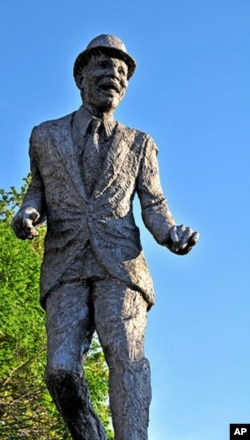In the years immediately following the American Civil War of the 1860s, thousands of African Americans, including former southern slaves and black northern soldiers, moved into a lively neighborhood in Richmond, Virginia - the capital city of the defeated Confederate States. It's Jackson Ward, which is remembered as the Harlem of the South, during this month's celebration of Black History Month.
Richmond is sometimes called the Monument City because of its boulevard of memorials to white, Confederate generals and admirals, as well as a lone African American statue of tennis star Arthur Ashe. But in a grittier part of town stands another, far more jovial statue. High on a pedestal, a concrete figure waves a bowler hat above his head as he dances up a short flight of stairs.
Bill "Bojangles" Robinson, the pioneer tap dancer and singer who dazzled vaudeville and movie audiences in the 1920s and '30s, is Jackson Ward's most famous son.
During the first half of the 20th century in rigidly segregated Richmond, Robinson and other black celebrities including bandleaders Duke Ellington, Cab Calloway and boxing champion Joe Louis frequented night spots and athletic clubs on the Deuce. That's Second Street, the heart of the action in Jackson Ward.
This was the birthplace of black entrepreneurship in the United States. African Americans formed their own financial institutions and prospered in medicine and law.
In 1903, a woman known as Miss Maggie, Maggie Lena Walker, became the first woman of any race to found and become president of an American bank.
Jackson Ward is largely blighted these days, but the attractive Walker home is now a National Historic Site in the heart of the Harlem of the South.













